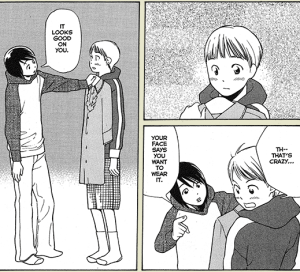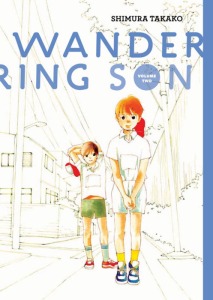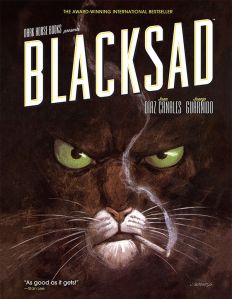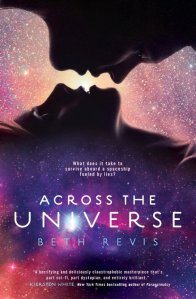Title: Wandering Son: Volumes 1 and 2
Author: Shimura Takako
Star Rating: * * (Volume 1), * (Volume 2)
Genre: Graphic Novel, Transgender/Gender Identity
Volume 1
When I heard that Wandering Son was about two kids, Yoshino and Shuichi, dealing with trans identity issues, it skyrocketed upwards on my to-be-read list. After all, there are not many stories dealing with trans realities in a positive and well-thought out manner, and I was super excited to see that this series was receiving excellent ratings. Unfortunately, volume 1 did little to endear me to the series as I thought that both the art and the story were weak.
The Wandering Son volumes are packaged in beautiful, oversized hardcover editions. Regrettably, the series would have looked better in the normal, smaller tankobon size. Takako’s art is very simplistic and sparse. While the printing is clear and crisp, by enlarging the pages so much, the blankness of many of them was emphasised, as well as the weaknesses of the character designs. While is it not uncommon for manga to have rather barebones backgrounds and similar character constructions, I felt that both were an impediment to my immersion in this story. I kept getting characters mixed up since most had the same, wide-eyed face, and even the hair styles weren’t all that different. Very little stood out to me in regards to the art, and I missed the detail that is often present in so many popular manga.
Another major issue I had with the book was the way in which decompression was used. Decompression refers to the pacing of a graphic story. A decompressed story is one that moves slowly, and can take many panels to show small events or reactions. This particular technique is quite common in Japanese manga, and I usually quite appreciate the more sedate, but detailed pace. However, the decompression in this volume left too many gaps in the narrative for me to fully understand what was going on. Scenes would be quite detailed, but then the story would jump forward to a different day or week. Very little time was spent on transition scenes, and even though these can be less interesting or emotional, they are still crucial to a well-constructed story.
Finally, I am sad to admit that there was just not much happening in this volume. Yoshino and Shuichi are just starting to figure out that they may be different, and it is understandable that they need time to sort out their feelings. However, most of the manga is comprised of Shuichi looking distressed and uncomfortable while she stares at things. When dealing with an introverted character that is rather shy and withdrawn, an author has to work particularly hard to make their struggles engaging and understandable for the reader. In the Wandering Son, we don’t get that far into Shuichi’s head, and being pummeled with panel after panel of emotional angst that isn’t very well conveyed does not make me feel for the character, or want to know more about her journey.
Overall, volume one starts off with a very interesting and potentially powerful premise that unfortunately just does not pay off.
Volume Two
Volume two is where everything really starts to fall apart for me. Technically, the book is a lot better than volume one. The story flowed a lot more smoothly, and I wasn’t getting lost between scenes. I still had many problems telling characters apart, but there were also more characters introduced that looked sufficiently different that the volume felt less same-y than before. Furthermore, the character development was more interesting, and Yoshino and Shuichi were doing more than just spending pages upon pages looking stricken and nervous. Overall, volume two was a much more enjoyable read except for one rather gigantic problem that ruined the entire book for me.
Trigger Warning: Sexual Violence
My issues with this book center on the two characters: Yuki and Shii. Yuki was actually introduced in volume one in a short, but disturbing scene. During Yoshino’s first public appearance as a young boy, Yuki hits on him rather directly despite the fact that Yuki looks to be in her twenties and Yoshino is a pre-teen dressed in a high school uniform. The scene was short, and I forgot about it until Yuki reappeared in volume 2. This time Yuki runs into both Yoshino and Shuichi wandering around as their preferred genders. She invites them over to her house, but tells Yoshino that she would love it if he came back alone one time. When the two kids come over again, Yuki expresses displeasure about Yoshino not coming on his own, and her partner, Shii, walks in just as she’s petting Yoshino’s face. He accuses her of having an affair with Yoshino, and the escorts the two kids out of the apartment. While in the elevator, he fondles Yoshino’s crotch and chest, acting quite surprised that Yoshino is biologically a girl. This leads both Yoshino and Shuichi to discover that Yuki is also transgender, and sets her up as a mentor for the two.
I have tried to come up with a positive interpretation for this scene, but I just can’t. Some have claimed the Shii tends to act spontaneously and was just trying to check to see if Yoshino and Yuki were having an affair, but that doesn’t excuse the fact that he sexually touched a minor. Under the law in my country, what he did is considered sexual assault, and the narrative even shows that Yoshino was quite disturbed and upset by the incident, yet these feelings were completely brushed aside. Given the disproportionate levels of violence perpetuated against trans and gender queer people, this supposedly gag-like scene is unacceptable. I was even more discomforted by the fact that Yuki was supposed to be a mentor for the two pre-teens despite her inappropriate behaviour.
Before I abandoned the series, I wanted to see what would happen with Yuki. In volume 3, Yoshino goes to Yuki when his classmates have found out that he and Shuichi are gender queer and have begun to mock and torment the two of them. Yuki acts completely inappropriately with Yoshino, asking to compare their panties, and wanting to bath together so that she can see his breasts. She encourages Yoshino to share a bed with her, and then she cuddles with him in a way that makes Yoshino uncomfortable enough to run away as Yuki is far too physically close, and saying uncomfortably intimate things. The two end up “making up” by the end of the chapter, and once again I was left feeling extraordinarily uncomfortable at the fact that a pre-teen was just molested by an adult who suffered no repercussions for her actions. For a manga that spends so much time delving into controversial and difficult concepts, it was a terrible error to write plots involving violence without unpacking them with the same care and respect as the other difficult issues approached by this series.
Final Thoughts
I was really excited to read Wandering Son when I heard that it dealt with gender identity issues. However, I wasn’t a fan of the story, and there are some extremely problematic aspects to the narrative that I just can’t brush aside. Violence, particularly sexual violence, is perpetuated against trans people all the time, and I cannot support or enjoy a story that uses this violence as a gag. Even if this is one of the few substantive stories about kids dealing with trans identities, the scenes in volume 2 make it a highly inappropriate and problematic read.












